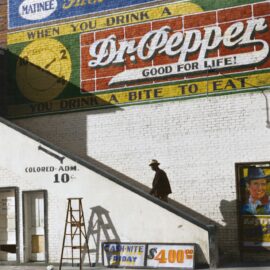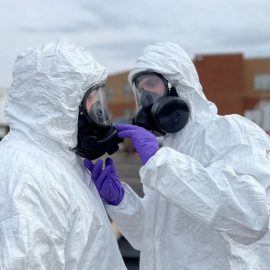

This article is an excerpt from the Shortform book guide to "Thank You for Being Late" by Thomas L. Friedman. Shortform has the world's best summaries and analyses of books you should be reading.
Like this article? Sign up for a free trial here .
What is Thomas Friedman’s Thank You for Being Late about? What are the three main forces that, according to the author, are shaping the current landscape of the world?
In Thank You for Being Late, Thomas Friedman aims to explain: what the current conditions (as of 2016) are and how we can best adapt to them. He discusses how these conditions arose as the three forces that shape the world (technology, globalization, and climate change) all accelerated at once—and how we can adapt to them.
Below is a brief overview of the takeaways from Thank You for Being Late by Thomas Friedman.
Thomas Friedman: Three Forces Are Shaping the World
According to Thomas Friedman in Thank You for Being Late, there are three major forces shaping the world: technology, globalization, and climate change.
These three forces all interact, and growth in one drives growth in the other, which is part of why the world feels so unstable today—everything’s changing at once. For example, technology and climate change interacted when the invention of the gas-burning engine contributed to climate change.
Technology
Technology is the first force that is shaping the world. It accelerates at an exponential rate, according to Moore’s law, which states that computational processing power will double every two years with only small increases in price.
The author discusses the five parts that make up computers and how they’ve dramatically advanced in a short time:
1. Sensors are devices that recognize environmental factors such as light, pressure, oxygen concentration—almost any of the things humans recognize using their senses—and then report this information to a computer via a signal. Over the years, sensors have gotten smaller, more efficient, and cheaper as materials and nanotechnology improved. Today, sensors, combined with people, make problem-solving much more efficient.
- For example, Bigbelly garbage cans are fitted with sensors that can determine when they’re full. Once at capacity, they send a signal to garbage collectors. This saves collectors a lot of time—they never have to guess if a pickup will be necessary.
2. Storage is technology that retains data. (Sensors and their ability to collect large amounts of data wouldn’t be of any use if we have no way to keep the information around long enough to analyze it.) Over the years, storage capabilities have improved as memory chips became more powerful and software made them more efficient. Today, collecting, storing, and sharing information is almost free, and there’s no tradeoff between cost and speed—you can have both.
- For example, Hadoop is a system that links hundreds of computers to combine their processing power and storage capabilities. Hadoop allows companies with large amounts of data, such as LinkedIn, Facebook, and Twitter, to analyze their data.
3. Software is a program that tells a computer what to do. Over the years, software advanced in two ways: by improving software-writing tools and increasing collaborative tools—the more great minds that work on a project, the more impressive the results of the project will be. Today, the open-source community collaborates to quickly create powerful software.
- For example, Microsoft originally only ran on Windows, and when the company made the decision that they wanted it to run on the operating systems Linux and Mac too, they released the code to the public on a platform called GitHub. Impressively, the GitHub community created the Mac version overnight.
4. Networking is the system of cables and wireless networks that connect computers and smartphones all over the world. Via these cables and networks, people can share anything that can be digitized. Over the years, it became faster and cheaper to transmit information as wires improved and networking software and new standards were developed. Today, it’s possible and very inexpensive to transmit huge amounts of data quickly and networking is crucial to the acceleration of the other three computer components above because it allows new advances to be shared all over the globe.
- For example, in 2013, the internet in Chattanooga was fast enough that T Bone Burnett (in LA) and Chuck Mead (in Chattanooga) were able to perform a duet of “The Wild Side of Life” without any lag.
5. The “supernova” (the cloud) is a term for the services and software that run on the internet instead of locally on your computer. The supernova is unique because it’s both powerful and far-reaching—in the past, the tools were only one or the other. Today, you can access anything on the supernova from anywhere in the world, on any device, as long as you have internet access.
- For example, Watson, a cognitive computer, lives in the supernova. Watson isn’t just a repository of information, however; it helps doctors with diagnostics: If IBM gives Watson 3,000 images, 6% of which show melanoma, Watson will use its algorithm to determine distinguishing features of melanomas such as shape and color. Then, when it’s given an image of a patient, it can identify whether it shows a melanoma or not. If Watson handles the diagnostics, then a doctor can focus on the patient, leveraging the human-only skills of judgment and empathy.
Globalization
Accelerations in technology have resulted in a corresponding acceleration in the second force that shapes the world, globalization—the flow of knowledge and information that connects the world and makes every part dependent on all the other parts.
There are four types of globalization:
1. The flow of technical knowledge. The supernova makes it possible to share technological advances all over the world.
- For example, Aloke Bajpai initially worked in the US, where he gained his technology knowledge, before returning to India to start Ixigo.com. Ixigo is a travel search program that helps Indians find cheap travel options. Bajpai used open-source software and the supernova to build Ixigo, and it will run on the least advanced cell phones, allowing more people to access it.
2. The flow of business. These days, it’s cheap and easy to start a global business—all you have to do is set up your small business with a Facebook page or sell products via Amazon.
- For example, in 2014, there were around 25 million small businesses on Facebook and just two years later, there were 50 million.
3. The flow of money. Globalization has resulted in the interdependence of markets and the ability for anyone to send money all over the world.
- For example, when China experienced stock market turbulence in summer 2015, the American stock market was severely impacted within a week.
4. The flow of human connections. Pre-acceleration, your community was the people who were physically close to you. If you left a community, you lost the old one and found a new one wherever you went. Now, you can keep in touch with anyone anywhere in the world and there are more ways than ever to connect and empathize with strangers—social media, gaming, international TV, and so on.
- For example, ISIS uses social media to find new converts all over the world.
Climate Change
The accelerations in technology and globalization are accelerating the third force that shapes the world, climate change. The climate is now changing at a pace greater than anything seen before in human history. The earth is good at maintaining equilibrium, so for some time, it’s been able to adapt to human effects. Today, however, changes are happening so fast and so globally that we’re approaching the limit of the planet’s ability to buffer the climate.
There are nine systems to consider when it comes to climate change. Scientists estimate that there’s a threshold, and if we exceed it, changes will become permanent. We’ve exceeded the threshold for the first four systems, we’re toeing the line for the next four, and we’re safely within the boundaries for the ninth.
We’ve Exceeded the Threshold
1. Global warming is an increase in the average global temperature since preindustrial times. The global temperature is affected by the presence of carbon dioxide, a greenhouse gas, in the atmosphere. The more carbon dioxide there is, the more heat the atmosphere retains. Scientists estimate that the boundary is 350 parts per million carbon dioxide concentration, and we’re currently at 400.
2. Biodiversity is the number of species on the planet and the habitats they live in. Biodiversity is closely related to climate—trees take in carbon dioxide and trees require the presence of other living creatures to survive such as pollinators, soil microorganisms, and animals that spread their seeds. Scientists estimate that the boundary is no more than a 10% loss of biodiversity from preindustrial times, and no more than a 0.001% loss of species per year. Currently, in parts of Africa, biodiversity has dropped to 84%, and species loss is between 0.001% and 0.01% per year.
3. Deforestation is the loss of forests and trees. Scientists estimate that the boundary is no more than a 25% loss of the planet’s forest cover since preindustrial times and we’re at 38%.
4. Biogeochemical flows refer to the number of nutrients in the environment. Nutrients such as phosphorus and nitrogen are necessary for life—if plants and animals don’t have enough, they can’t grow—but the presence of too many nutrients chokes them. Nutrients are found in fertilizers and pesticides, and we’re currently overusing these products. Scientists estimate that the boundary is 25% less than we’re currently using.
We’re Toeing the Line
5. Ocean acidification is the ocean’s absorption of carbon dioxide. When carbon dioxide mixes with water, the reaction produces carbonic acid. This acid dissolves calcium carbonate, which is a key ingredient of the shells of marine organisms. The acid also harms coral reefs and fish.
6. Freshwater use is the amount of water we can take from groundwater sources and rivers. If we take too much water, wetlands and rainforests will dry out.
7. Atmospheric aerosol loading is the tiny pollution particles in the atmosphere—such as the ones that make up smog—that come from burning fossil fuels. Pollution blocks sunlight and makes it more difficult to breathe.
8. Chemical pollution is the release of chemicals such as plastic and nuclear waste into the environment. These compounds would never form naturally and affect the environment in unpredictable ways—they might even eventually change organisms’ DNA.
We’re Safely Within the Threshold
9. The ozone layer is a shield in the atmosphere made of a gas called ozone. This layer protects the planet from the sun’s ultraviolet radiation, which can cause skin cancer. In the 1970s, scientists learned that chlorofluorocarbons (CFCs), a human-made chemical, were damaging the ozone layer. In 1989, the world collectively banned the use of CFCs and the ozone layer recovered.
Population growth has a large effect on the nine systems above because the more people who live on the planet, the more resources they need to stay alive and healthy. For example, to grow enough food to feed everyone, we’ll have to use more fertilizer, water, and fossil fuels to power farm machinery, which will further degrade the planet.
The United Nations predicts that in 2050, the earth’s population will be 9.7 billion, which will be unsustainable. To control the population, we need to provide easy access to contraception, educate women and give them control over their reproductive choices, and introduce modern gender norms.
Adapting to the Three Forces
Now we understand all three accelerating forces acting on the world—but what do we do about them? There are two options: 1) try to slow things down, or 2) increase humanity’s ability to adapt.
Option 1, putting on the brakes, isn’t going to work. It’s impossible to stop the accelerations and regain static stability. Even if it wasn’t impossible, the accelerations have created some major problems, such as climate change. We need the accelerations, particularly of technology, to come up with solutions.
Option 2, adaptation, is the only way forward. Adaptation involves:
- Striving for dynamic, rather than static, stability. An example of dynamic stability is riding a bike—you can’t balance if you’re not moving, but once you are moving, you only need to make steering corrections, not create new momentum.
- Increasing the pace of innovation in social technologies (laws, organizations like the UN, and so on) with the goal of catching up to the pace of innovation in physical technology (cell phones, microchips, and so on). Even if we only slightly increase our ability to adapt, it will make a difference.
There are five sectors that require innovation in social technologies: 1) the workplace, 2) geopolitics, 3) domestic politics and culture, 4) morality, and 5) society.
Sector #1: The Workforce
The three accelerations have changed the first sector, the workforce, in the following ways:
1. Middle-class jobs now require more education and knowledge, and to be part of the middle class, you have to work harder, participate in professional development, and deal with shifting employment regulations. Additionally, the increasing requirement for bachelor’s degrees or formal accreditation bars a lot of people from middle-class jobs.
2. Most jobs will change and become partly automated or require new skills.
- For example, taking messages used to be done by telephone operators. Now, it’s part of a receptionist’s duties and is partly automated by voicemail.
3. Single jobs are being split into high- and low-skilled jobs. The high-skilled part will require more skill and pay better, and the low-skilled part will be automated or paid minimum wage.
4. There’s more competition for jobs, either with international workers or automation.
5. “Stempathy” jobs—jobs that require both technical (science, technology, engineering, and math) and people (empathy) skills—are the jobs of the future because technology will never be able to replace or automate human empathy.
To adapt to these changes, we need to rethink the workplace by:
1. Establishing lifelong learning programs. Today, at best, your education prepares you for your first job, and you have to keep learning throughout your life because the world and your job will change over time.
- For example, Udacity offers online courses on, among other things, brand-new technology. They’re able to release courses just months after new technologies appear.
2. Building tools to help match people and their skills to jobs. While technology endangers jobs to some extent, it can also be used to improve the workforce.
- For example, Opportunity@Work tests people who have tech skills but no formal credentials. Opportunity@Work then certifies them, connects them with employers, or points them towards more training.
3. Revising social contracts. The relationships among workers, schools, companies, and the government need to change to adapt to the age of accelerations.
- For example, the relationship between bosses and employees needs to change. Bosses need to hire people based on their skills, not their credentials, and employees need to engage with the opportunities that their bosses provide and work hard.
Sector #2: Geopolitics
The three accelerations have changed the second sector, geopolitics, in the following ways:
1. Average nations have become weak. New nations who don’t have the resources to create strong governments or industries used to be able to rely on foreign help, but the US and other superpowers no longer have the resources or motivation to help.
2. Threats are no longer obviously galvanizing (for example, in the way Nazism and its disregard for human rights galvanized the Western world to oppose it) and can’t be solved simply with armies and a conclusive victory on a particular date.
3. The US has to both contain and work with superpowers Russia and China. The world is so interconnected now that the fall of other superpowers might actually be more dangerous for the US than the rise, and allies can quickly become enemies.
- For example, if China collapsed, there could be a global recession.
4. Due to globalization, disorder in any part of the world affects the rest of the world too.
- For example, thousands of young male migrants from various parts of Africa, which is disordered, meet in Agadez, Niger. On Monday evenings, they pile into trucks to travel through Libya (which is war-ravaged) and hopefully on to Europe, a more ordered part of the world, to find jobs. Neither Libya nor Europe wants to let most of the migrants in.
5. Breakers—individuals or groups who want to cause chaos—are more powerful than ever because they have access to information via the supernova. (Friedman contrasts breakers with “makers,” people who use the accelerations to build new things or improve old things.)
- For example, it’s now easy to source inexpensive bomb-making materials online. It only costs $100 to make an IED, a simple bomb.
6. Social media can help people end oppression but fails to help them create new systems.
- For example, in Egypt, President Hosni Mubarak resigned after protests that were organized on social media. However, post-protests, the population became polarized because social media was used to spread rumors and hate speech.
To adapt to these changes, we need to rethink geopolitics by:
1. Amplifying. Give people educational opportunities and economic opportunities, both of which allow people to stay in their countries instead of migrating in search of resources or work.
- For example, after the Arab Awakening, the US gave Lebanese students $13.5 million worth of local college scholarships. At college, they learned about tolerance, critical thinking, and social and gender equality, all of which will help bring stability to the region.
2. Deterring. The US maintains enough power to stop countries from acting in ways the US doesn’t want them to.
- For example, the US needs to maintain its nuclear power so that other countries, especially Russia, China, and North Korea, won’t use theirs.
3. Degrading. Discourage breakers from causing chaos and cutting them off from their leaders if they’re part of a group.
- For example, if a Palestinian village doesn’t approve of suicide bombing, members of the community will be less likely to engage in these nonapproved behaviors because they don’t want their community members to shame or hate them.
Sector #3: Domestic Politics and Culture
The three accelerations have changed the third sector, domestic politics and culture, in the following ways:
1. Political impasses. After the massive technological changes in 2007, the 2008 recession hit, and politics stalled because leaders couldn’t explain the situation to citizens and failed to implement policy changes, such as technology regulations, that would have helped people adapt. This left space for populists who promised to hold back changes.
2. Refusal to compromise politically. The two parties became too committed to their identities (and too reliant on their funders) to consider ideas that didn’t fit neatly into their platforms.
- Example #1: The Republicans have always opposed immigration, but in these accelerating times, increasing legal immigration may be a key to adapting to globalization.
- Example #2: The Democrats have always supported regulation, but overregulation is expensive and can depress economic growth and therefore job creation.
To adapt to these changes, we need to rethink domestic politics and culture by:
1. Studying Mother Nature. Mother Nature has enormous buffering capacities and many people, including the author, have looked to it for an example of how to handle accelerating change.
- For example, one of Mother Nature’s buffering capabilities is adaptation. Ants have developed the behavioral adaptation of assigning their populations different jobs—some ants babysit, giving other ants the freedom to look for food across a wider area.
2. Applying Mother Nature’s buffering capacities to domestic politics and culture.
- For example, Mother Nature’s ability to adapt can inform our ability to adapt. When a country, culture, or individual is presented with another party that’s more successful in some way, if the culture chooses to learn from the stranger, they’ll change for the better.
Sector #4: Morality
The three accelerations have changed the fourth sector, morality, in the following ways:
1. Everyone has godlike powers.
- For example, advances in genetics make it possible for humans to create new organisms.
2. More spaces are unregulated by humans.
- For example, the YouTube ads that run before videos are assigned by an algorithm, not by YouTube staff or the companies who buy the ads. As a result, no one actually knows where the ad will be placed unless she happens upon the video the algorithm selected. This algorithm has resulted in Aveeno, Secret, and Bud Light ads playing in advance of jihadi and ISIS videos. The algorithm had no human judgment to inform its selections.
To adapt to these changes, we need to rethink morality by:
1. Increasing ethical education.
- For example, the author suggests teaching everyone the Golden Rule—treat others as you want to be treated. The Golden Rule will be effective no matter how much the age of accelerations changes the world because it’s adaptable and scalable and applies to any situation.
2. Building healthy communities. Community members watch out for each other and encourage and discourage certain behaviors. Character isn’t usually something that’s developed by an individual; it’s a group effort.
- For example, the Paris climate agreement is an example of a global community. The agreement was designed to slow climate change, which affects everyone on the planet, and 175 countries signed.
Sector #5: Society
The author presents his hometown, St. Louis Park, Minnesota, as a model for how society, specifically communities, can adapt to the accelerations. St. Louis has been successful at adapting because it has implemented the following strategies:
- Class and culture mixing as a response to globalization. People of different backgrounds and cultures regularly encounter each other in well-funded public spaces such as schools and near the lakes.
- Good politicians as a response to all three accelerations. St. Louis Park politicians compromise and work together, so they can quickly respond to any change.
- Public-private collaboration as a response to all three accelerations. Businesses feel obliged to provide jobs, fix local problems, and volunteer in the community.
- Community-minded citizens as a response to all three accelerations. The public has high expectations for politicians and business leaders, and they support community efforts even when they don’t personally benefit.

———End of Preview———
Like what you just read? Read the rest of the world's best book summary and analysis of Thomas L. Friedman's "Thank You for Being Late" at Shortform .
Here's what you'll find in our full Thank You for Being Late summary :
- The problems that arise when the world changes faster than humanity can adapt
- How to adapt to technology, globalization, and climate change
- The importance of taking time to reflect and reorient






